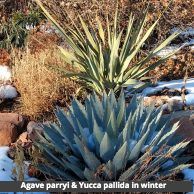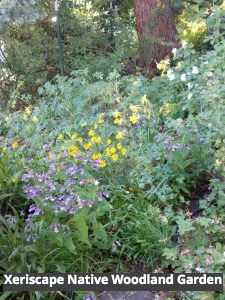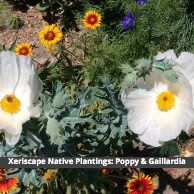This article is reprinted, with permission, from Harlequin’s Gardens’ June 15, 2021 newsletter. Harlequin’s Gardens is a family nursery and garden center dedicated to natural and sustainable gardening for our region. We at Wild Ones Front Range Chapter thought the article worthy of wider circulation as we face drought and higher temperatures across the Western United States. Wouldn’t it be wonderful if we all cut our water usage in half, as recommended in the article!
Since the drought of 2002, there has been some real progress in understanding and appreciating xeriscape or water-wise landscaping. And yet some people thought “the drought is over, and we can go back to assuming that we have as much water as we want.” But it is predicted that with climate change we will have more and longer periods of drought, and it would be painful to be as unprepared as we were in 2002. That was our wake-up call. Fortunately, gardeners are generally smart and caring people, and their values are changing. They are more interested in sustainable landscapes, and they want more economical landscapes and gardens that need less water, time, energy, and money. And of course that means using plants and methods that are adapted to Colorado conditions.
We live in a semi-arid region that receives about 12-20 inches of moisture a year. To have a drought, we only need to miss a few spring snows or rains. If rainfall is below average, or if we have high winds, or if temperatures are higher, conventional landscapes will require more water. And it is obvious that as our human population rises, water is becoming more scarce and more valuable. In 2005, the Colorado Legislature passed the Colorado Water for the 21st Century Act, and a 2005 Memorandum of Understanding by 32 metro mayors in Denver outlined their commitment to wise use of water in their communities. And Boulder put its water budgeting program into effect in January 2007. My point is that pressure is coming from many directions to conserve water, and that means it is time to learn to design and to make gardens and landscapes that use less water. It is time for xeriscape to become a mainstream method of landscaping in Colorado.
Since “xeriscape” can mean differing irrigation rates, I am going to use this word to mean a landscape that requires half the irrigation of a bluegrass lawn that is watered conventionally (which is about 25-30 inches of water per season), so a xeriscape would need 12-15 inches of irrigation per season, or less. I think this is a very generous definition, because I know of some good xeriscapes that receive only 5-8 inches of irrigation per season. Most of the demonstration gardens at our nursery, Harlequin’s Gardens, have been watered five times a year, or less. But cutting the water use in half is a good goal. Another way of expressing this is to say that a xeriscape should be watered no more than once a week, deeply, increased to twice a week in July. This applies after the plants have been established for 6-12 months.
Xeriscape does limit water use but does not dictate any style. A xeriscape garden can be formal, naturalistic, or highly personalized. It can be mostly ground covers, mostly shrubs, mostly evergreen bushes or mostly grasses. It can be mulched with wood chips, rock chips or ground covers.
 It is common for people to think of xeriscape as a limitation, but there are opportunities with xeriscape that you don’t get with conventional landscaping. For example, people say “A lot of plants can’t be grown dry, so you must have a smaller plant palette to work with.” Certainly, there are plants you can’t grow in a xeriscape, but there are hundreds of great xeriscape plants that actually won’t survive with 30 inches or more annual rainfall. Many of our Colorado native plants won’t survive moderate irrigation. Big Sage and Apache Plume will rot or look terrible if watered the same as Kentucky Bluegrass, and even “industrial strength” plants like Snow in Summer, Basket of Gold, and most yarrows will grow sloppy and/or develop fungus problems with moderate watering.
It is common for people to think of xeriscape as a limitation, but there are opportunities with xeriscape that you don’t get with conventional landscaping. For example, people say “A lot of plants can’t be grown dry, so you must have a smaller plant palette to work with.” Certainly, there are plants you can’t grow in a xeriscape, but there are hundreds of great xeriscape plants that actually won’t survive with 30 inches or more annual rainfall. Many of our Colorado native plants won’t survive moderate irrigation. Big Sage and Apache Plume will rot or look terrible if watered the same as Kentucky Bluegrass, and even “industrial strength” plants like Snow in Summer, Basket of Gold, and most yarrows will grow sloppy and/or develop fungus problems with moderate watering.
Most maintenance or landscaping professionals probably know that more plants die from over-watering than from under-watering. But it is common for gardeners to think that if a little water is good, a lot of water is better. This is untrue because plants need oxygen just as animals do, and when the soil is saturated with water, the oxygen is driven out. Without oxygen, the plants can’t metabolize properly, and the roots can’t grow.
So Here are the Opportunities With Xeriscape:

- You can grow many Colorado native plants and other dry-loving steppe and high desert plants much more successfully.
- You can create a genuinely Colorado or western landscape that reflects and praises the natural beauty of the nature around us.
- A xeriscape and native garden will support many more pollinators and beneficial insects.
- A xeriscape is more environmentally responsible and more sustainable since it uses so much less of our precious water. It also usually requires little or no fertilization and pesticides. Why? Because xeric plants often come from areas that are naturally lean with little soil fertility, and because if they are given little fertilizer and little water, their tissues are tough and less succulent and therefore less attractive to fungi and insects.
- An obvious opportunity and selling point is the fact that water bills will be lower. This factor will become more and more significant as the price of water continues to rise. In addition, more and more communities will be adopting water budgets, and a low-water landscape makes it easier to stay within your budget.
- A xeriscape will survive a drought and water restrictions far better than a conventional landscape. This point would have been much more obvious if the drought of 2002 had been followed by another drought in 2003.
- A xeriscape can require less maintenance. In conventional landscapes with ample water and fertilizer, more work is required to cut back plants after flowering, and there are usually more and bigger weeds because many weeds, especially grasses, thrive on ample water. And with less water, there are fewer fungus problems and fewer problems with sucking insects like aphids, which means less maintenance. Even deer are less attracted to dryer plants. (Note that excessive drought stress can increase maintenance problems.)
- One of the best opportunities of xeriscape is the winter garden. Unlike English perennial borders and cottage gardens which turn brown and dead-looking in winter, the well-designed xeriscape can be attractive, interesting, and colorful in winter. Xeriscape plants are often sculptural or textural. Color in winter is not from flowers but from ornamental grasses, the bark of shrubs and trees, and from evergreen foliage mats and mounds of dark green, gray, silver, blue and many different reds. These rock garden-type plants come from areas like our own, where snow-cover is short-lived, so plants can continue to photosynthesize. A good xeriscape can be very enjoyable to walk through on a warm Colorado winter day. So, when you design your xeriscape, don’t miss this opportunity.
Tricks of Xeriscape
In the last section I discussed the opportunities with xeriscape that you don’t get with conventional landscaping. Now I am going to share some of the tricks that can improve the outcome of a xeriscape garden. The first seven tricks are what I call “Water Equivalencies”. Even plants that grow where it’s hot and dry will thrive better, and often look better or flower better with some extra moisture, and these tricks will give them extra moisture without increasing irrigation.

Shade equals water. During the 2002 drought, because of water restrictions, a lot of lawns were brown by August, but the areas under trees often were still green. This is a clue that shade equals water. So, if you put plants that prefer more water on the east or north side of buildings or fences, they will be protected from all day and hot late afternoon sun. With this shade they will do better with the same amount of water. If you read that a plant needs full sun and you know it is not very drought tolerant, you can often plant it in part shade, because a half day of Colorado sun is usually equal to full sun in the East or Midwest.
Planting among rocks equals water. Perhaps this works because with our cool Colorado nights, water condenses and runs under rocks. But whatever the reason, under dry conditions, a plant next to a rock or between rocks will often thrive or survive while the same plant a foot away may struggle or die. Ideally, the rocks should be partly buried. Rock gardens and Crevice gardens are built with stones that are at least half underground. Aside from mimicking nature, this enables roots to shelter in a much moister, cooler environment.
Soil preparation equals water. Organic matter such as compost or manure holds moisture for longer periods of time, and soil that is loosened and is not compacted permits rain to penetrate and get down to the roots. Compost also is food for mycorrhizae, the beneficial fungi that can extend the reach of plant roots up to 700 times to increase water availability.

Mycorrhizae equal water. Because mycorrhizal fungi get to work right away when spores are applied directly to plant roots while transplanting, we have found that new plantings can establish much more rapidly, and plantings in hot weather can be much more successful.
Wind protection equals water because wind can be so desiccating. Sometimes roses die back in the winter not because of cold, but because wind has dried out the canes, and evergreens are especially vulnerable to drying by wind. A xeriscape garden with a wind break or fence on the west side will require less water.
Mulch equals water, as we know; it keeps the water in the ground from evaporating. And besides organic mulches, fine gravel like squeegee makes a good mulch for penstemons and other rock garden plants that would rot under organic mulches like bark and wood chips. Even ground covers can act as an effective mulch.
Dead-heading equals water. This one is not so obvious, but the most energy-intensive stage of a plant’s growth is the making of fruits and seeds. A plant is receiving little water can decline or even die after going to seed. So, if you dead head right after flowering and before seed-set, plants will recover much more quickly, and will often live longer. This is very true of Penstemons, many of which have the reputation of being short-lived. Removing at least half of the spent flower stalks extends their lifespans considerably.
Here Are a Few Other Tricks for Xeriscapes

“Right Plant in the Right Place” is a trick that will improve the outcome of any type of garden. One way to make a garden sustainable is to put each plant in a spot where it is best adapted. I knew a highly successful farm manager who told me that everyone who came to him wanted the same thing: “a good farm”. And at first, he tried to give them his idea of a good farm with flat, rich ground. But he later learned that what people meant by “a good farm” was one like they grew up on or had worked before, because they knew how to make money on that kind of farm, even if it was hilly and rocky. Plants are like that too, so give them the soil and exposure like where they originated, even if that means hot, lean, and dry. Plants that come from cooler conditions will melt in hot locations, so put them in some shade. If a plant is commonly found growing on South or West-facing slopes, you’ll know it is more sun-tolerant.
Most of you know this, but it is worth mentioning that it is very important to group your plants by water needs. Put the high-water plants together and the low water plants together. If you don’t do this, you will have to water all the plants enough to keep the most moisture-loving plants alive. This will waste water and rot the true xeric plants. I have an area on the east side of my house that I give a little more water and can grow campanulas, foxgloves and gentians that would not survive in the rest of my xeric garden.
Another trick is, if you plant the edges with attractive low-water groundcovers, the entire landscape looks better, even if it has dried out in July. This will be even more true if the ground covers are evergreen and if they have their own drip system.
The last trick is for professionals. It is very important to educate clients about what to expect with a xeriscape. People often have unrealistic expectations about a new garden, and sometimes the landscaper has done such a good sales job that they are expecting the Hanging Gardens of Babylon. Tell them the truth: “This is a xeriscape; it may not look as lush as a garden in Connecticut or Seattle, but it will have plenty of flowers, beautiful textures, colors of foliage, beautiful shapes and rhythms. It will support beneficial insects, pollinators and birds; it will save water and pest management; and you will be able to enjoy your garden in the winter.” But if all they really want is “masses of flowers all season long”, maybe they shouldn’t have a xeriscape, and it’s better to know this upfront.
Potential Drawbacks to Xeriscape
There are some potential drawbacks to xeriscape which should be admitted, but there are ways to reduce their impacts. In a xeriscape there are certain plants you won’t be able to grow because they require more moisture. If you must have them, select a small, high visibility area in a protected location like on the north or east side of the house or other structure, and group your high-water plants there, and give them more water. This is still xeriscape and water wise. Or plant other plants that are similar-looking but use little water. For example: instead of hostas, use Lady’s Mantle or Bergenia; instead of ferns use Sweet Cecily or yarrows; instead of Hybrid Tea roses, use heirloom Shrub Roses on their own roots; instead of New England Asters use western native asters like Smooth Aster (A. laevis).
Another potential disadvantage to xeriscape is that plants that are watered sparingly won’t fill in as fast as plants that are given ample water. To reduce the impact, water amply (but not excessively) the first year to get faster fill-in, then reduce the watering the following year, and mulch to cover bare areas. Also, low-water annuals can be planted to fill in the gaps for a year or two.
 Xeriscapes may bloom less than landscapes given ample water. However, there are some very long-blooming plants that thrive in low-water gardens – Chocolate Flower, Gaillardia, Catmint, Navajo Tea, California Poppies, Penstemon rostriflorus, hardy Geranium (Cranesbill) varieties, Engelman Daisy, Red Birds in a Tree, Larkspur, Standing Cypress (Ipomopsis rubra), Mongolian Gold Bush Clematis, Bear Claw Hellebore, and more. Other strategies to increase blooms in a Xeriscape include watering more during the blooming season to get more flowers, then cutting back after blooming, or planting self-sowing xeric annuals to get masses of color for 6-8 week periods. And you can plant large flowering shrubs and tough roses for big splashes of color. But remember – fewer flowers will not be noticed in a garden that is designed for sculptural forms, textures, foliage colors, variety of bloom times, for wildlife or for peaceful and meditative qualities.
Xeriscapes may bloom less than landscapes given ample water. However, there are some very long-blooming plants that thrive in low-water gardens – Chocolate Flower, Gaillardia, Catmint, Navajo Tea, California Poppies, Penstemon rostriflorus, hardy Geranium (Cranesbill) varieties, Engelman Daisy, Red Birds in a Tree, Larkspur, Standing Cypress (Ipomopsis rubra), Mongolian Gold Bush Clematis, Bear Claw Hellebore, and more. Other strategies to increase blooms in a Xeriscape include watering more during the blooming season to get more flowers, then cutting back after blooming, or planting self-sowing xeric annuals to get masses of color for 6-8 week periods. And you can plant large flowering shrubs and tough roses for big splashes of color. But remember – fewer flowers will not be noticed in a garden that is designed for sculptural forms, textures, foliage colors, variety of bloom times, for wildlife or for peaceful and meditative qualities.
Another disadvantage is that xeriscapes can look burned out and scruffy in July and August. In nature in Colorado, this is normal and not a problem if the plants can reproduce and/or come back strong the next year. But most homeowners and neighbors don’t like scruffy gardens. So, what is the antidote? In early July, do a thorough maintenance of dead heading, weeding and cleanup, followed by the longest, deepest watering of the year. This will give the garden a pick-up, new growth will be supported, and blooming will be encouraged for the summer and fall bloomers.

In Colorado we are looking for our own genuine landscape style. Traditionally, American gardens have been influenced by the English and Japanese styles, but both are more successful where there is ample moisture and temperatures are not too severe, like on the east and west coasts. Here in Colorado, we must discover a more appropriate style, using plants that are water-wise and cold hardy, like western natives and plants from similar regions around the world. And we need to apply methods that are adapted to Colorado conditions.
Beyond these guidelines, follow your own muse. Those of us who have been the leaders of the xeriscape movement for the past 30+ years will be looking to you for the innovations and solutions in the next 25 years of Colorado regional design. No magazine article is as powerful as the examples of our (your) own gardens in showing others that resourceful, ecological and water wise gardens can be beautiful and wonderful.
Harlequin’s Gardens recommends and sells some excellent books on Xeriscaping and water-wise plants:
Pretty Tough Plants by Denver Botanic Gardens
Waterwise Plants for Sustainable Gardens by Lauren Springer Ogden & Scott Ogden
The Xeriscape Plant Guide by Denver Botanic Gardens
Steppes by Denver Botanic Gardens
And more!
